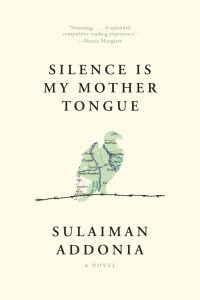Reviewed by Alyssa Schoonmaker

Imagine this. A trial is underway. The accused: Saba, a young girl recently displaced from her homeland of Eritrea. Her alleged crime: incestuous abuse of her mute older brother, Hagos. Now imagine yourself in these shoes. What will the jury see when you are brought up to the stand? What will they find through the lens of their judicial microscope? If your life became a movie, what would the reviewers at the premiere screening think of you?
In the opening of Sulaiman Addonia’s second novel, Silence is My Mother Tongue, we watch Saba’s life movie through the screen of Cinema Silenzioso, the refugee camp’s makeshift theatre created by a young boy named Jamal. A mere white sheet strung between two wooden poles, with a large square cut out of the middle, frames the daily events and ongoings of the camp. Addonia, who takes inspiration from his own journey from Eritrea to a Sudanese refugee camp at a young age, cleverly uses this (literal) framing device to establish from the start a sort of break from reality, a sense that these refugees’ lives are more a show than anything. The screen is a way of escape into stories, a means by which to make art of hardship and persecution. To Jamal and the rest, each refugee is a character in a film– and Saba plays the starring role.
Saba is Jamal’s favorite enigma. She is both Ethiopian and Eritrean, “half from an occupied country and the other half from the occupying”. She challenges traditional gender roles in devoting her time to studying rather than to become a ready wife. She is unashamed in her exploration of sexuality and self-pleasure. She is fluid, intelligent, unyielding in her independence– but that scares the rest of the refugees, who, through Jamal’s screen, see only her outward behavior. They scorn her differences and make every effort to pound out her independence, never making an effort to learn her mind or heart outside of what is framed by that billowing white sheet.
As readers, however, we are privileged to see beyond the edges of the frame. In a series of vignette-style chapters, Addonia allows us to dive deep into Saba’s growth: her and Hago’s early childhood traumas, their escape from Eritrea, and subsequent acclimation into the challenging environment of a refugee camp. A complex and symbiotic relationship between siblings forms before our eyes as they project their unconventional desires unto one another. Saba allows Hagos to dress and groom her frequently, letting him turn her into “the woman he carried within him”. In turn, Hagos gladly performs feminine duties, household chores and such, so that Saba may study and pursue her own secret dreams. Their fragile and beautiful relationship shines as arguably the only genuine one in the novel, a ray of light in a dark, uncertain place and time.
Though Saba frequently converses with secondary characters, becoming acquainted with neighbors and with a new lifestyle in camp, her most notable words are actually unspoken. Though Hagos is mute, Saba and her older brother speak volumes in this novel. They are unbound by the weight of words, free to feel rather than to define those feelings, but also forced to bear their own traumas in silence. There is a question of language, of the value of speaking: Saba sees how “the camp took one’s language as if it was flesh attached to bones”, and chooses silence over judgment. Rather, she places her trust in her own body and soul, and into that of her other half, Hagos. They suffer quietly and bravely together.
Addonia presents this all, unspoken and on-screen, with breathtaking ease. He is a master director, creating a contrast between what is seen by the characters and what is known by the reader, building depth and beauty that ultimately culminates in a tragic, impactful conclusion. He employs a matter-of-fact tone throughout, describing violence amongst the refugees in a way that suggests he wouldn’t blink an eye at witnessing any of it. Though undoubtedly influenced by his own experience in a camp, Addonia still maintains distance from the stories he tells, constructing the same barriers of numbness that the characters were forced to build even towards the most horrendous acts of physical and sexual violence. Still, this novel lacks no love, and Addonia’s heart for the subject and people is quite apparent in the tender thoughts Saba and Hagos have for each other. The pair will burrow their way into the heart of every reader, and their voices, though silent, will echo in your ears long after you flip the last page.
So again, I ask of you: If your life became a movie, what would the reviewers at the premiere screening think of you? But this is in fact not the question Addonia wishes us to answer. You cannot step into Saba’s shoes, for her life is hers alone, her experiences wholly intimate and unimaginable, her thoughts unique and private. However, you can step into the shoes of those reviewers. If your life became a movie, what would you think of yourself after watching it? Would you take the character on the screen at face value, or learn to look beyond the edges of the frame? Silence is My Mother Tongue challenges the reader to learn how to truly see, how to set circumstance and experience aside, how to find other humans as not a product of crime or achievement but rather as just that– human. Addonia leaves us striving to be better, to be kind and gentle, to live not as the main character in a movie but as an appreciator of the art that is life around us.
